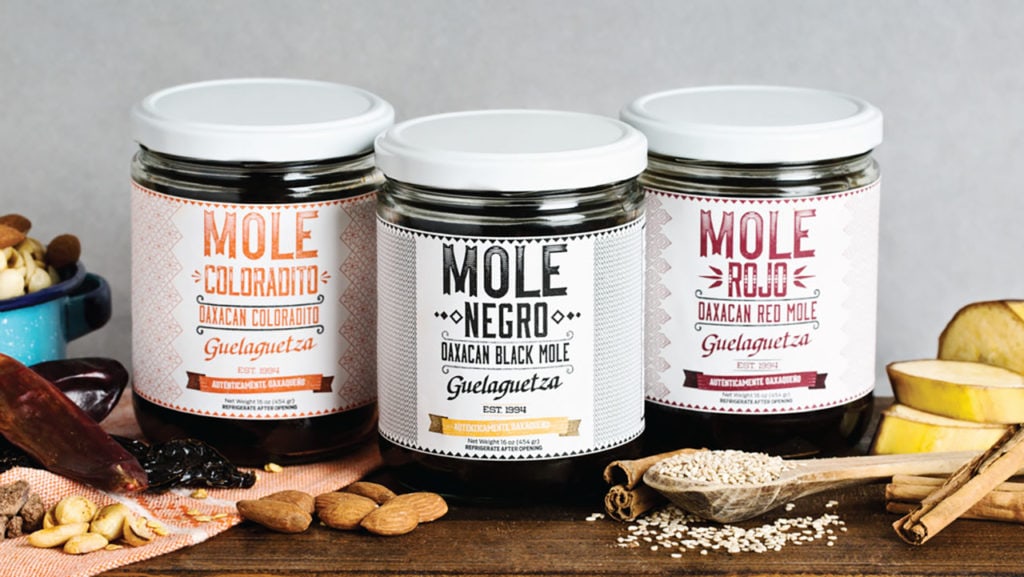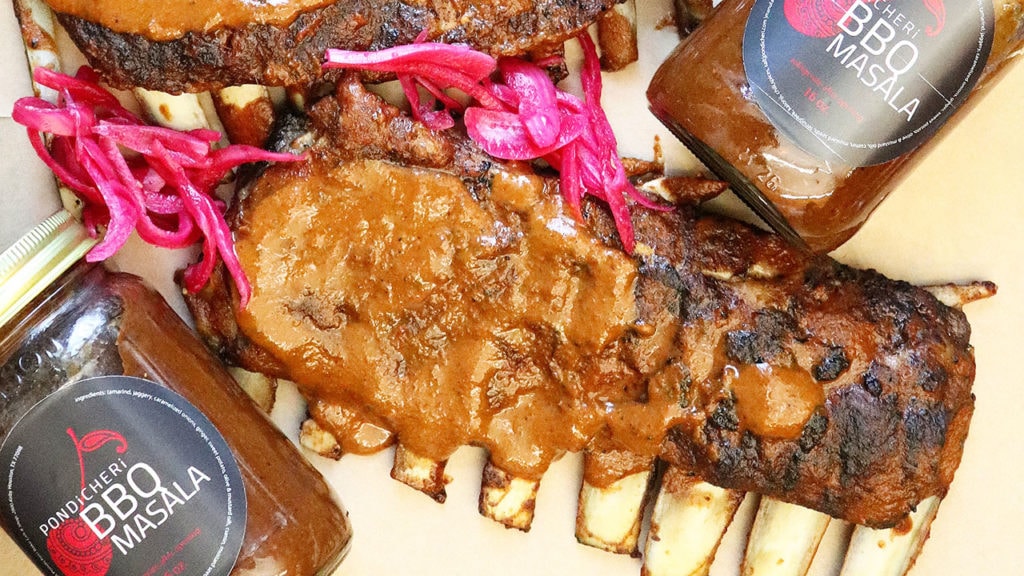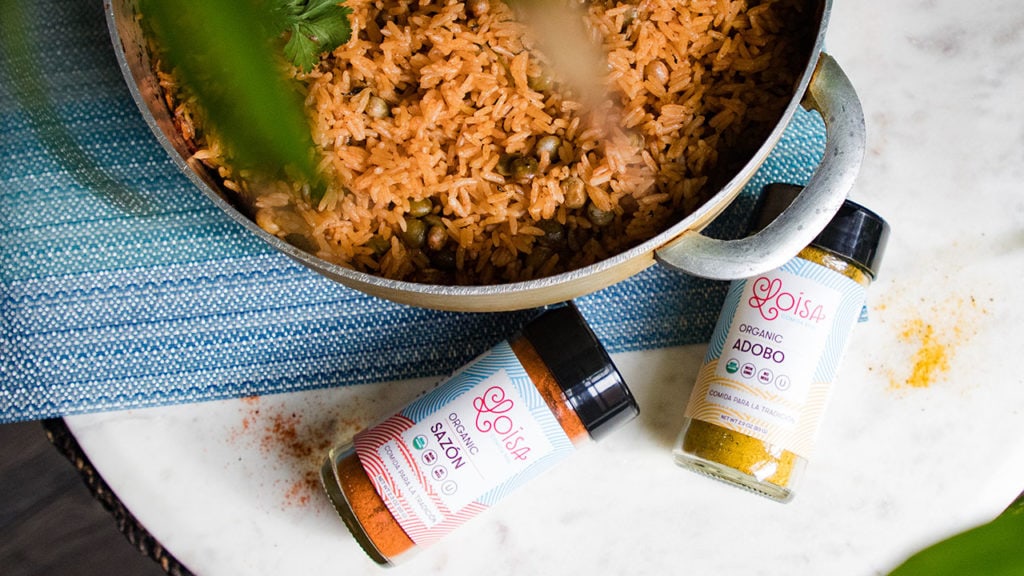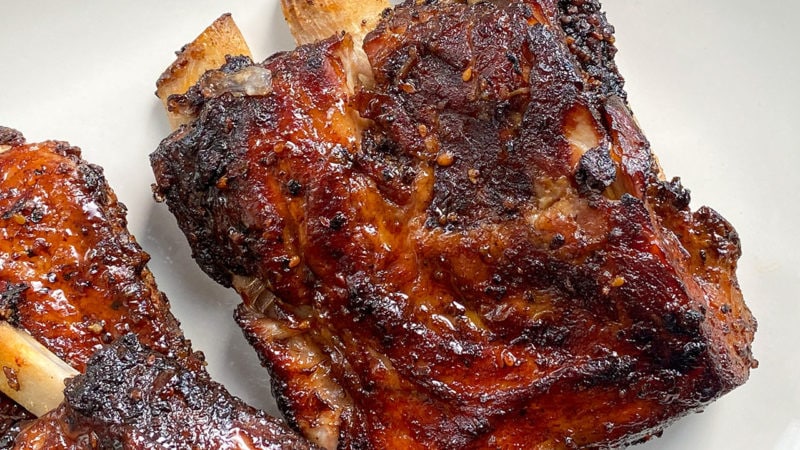Last Updated on June 16, 2021
To get big flavors at dinner, we often need something we just don’t have much of: Time. We also want to eat well and responsibly. This means avoiding quick fixes like overly processed foods and ingredients riddled with preservatives.
That’s why we’re looking to a few stellar companies who are just as concerned about quality ingredients as we are. These sauces, spices, accompaniments, and pastes are products you can count on to match the flavor, quality, and responsible sourcing of your ButcherBox meats.
Guelaguetza’s Mole Pastes
Whipping up a big pot of Oaxacan mole isn’t exactly feasible on a weeknight. But co-owner Bricia Lopez and her team at Guelaguetza are out to change that.
Bricia’s father, who came to the U.S. from Oaxaca, Mexico over 25 years ago with very little, and knowing practically no English, opened Guelaguetza restaurant in L.A.’s Koreatown. After years of hard work, the family business now holds a coveted James Beard award. It is also nationally recognized as an epicenter for authentic Oaxacan cooking.
Luckily for those who can’t make it out to L.A., you can still get the taste of Oaxaca at home with Guelaguetza’s mole pastes. Even though Bricia will tell you making mole from scratch isn’t as exhaustive as you think, the folks at Guelaguetza make it even easier. Their mole pastes can help you get a full-blown Oaxacan dinner on the table in less than 30 minutes.

Their three styles of mole paste are all magnificent and each shine in their own way: Mole Negro, Mole Rojo, and Mole Coloradito.
Mole is most commonly served with chicken, but Bricia also recommends using the paste as a rub with a little brown sugar, oil, and salt. “I love rubbing that on salmon or on a steak for grilling in the summertime.”
Mother-In-Law’s Gochujangs and Kimchis
Mother-In-Law’s founder, Lauryn Chun, wants to show eaters that Korean fermented products, like kimchi and gochujang, deserve their place on the shelves amongst more conventional fermented foods, like wine, cheese, and bread.
After every visit home to L.A., Lauryn’s mom, who has run a Korean restaurant for over 30 years, would send her back with loads of kimchi in her suitcase. Her friends back in New York were amazed at the unique and complex flavors. That’s when Lauryn saw an opportunity to get more kimchi onto American tables.
After launching in 2009 with their “House” kimchi, Mother-In-Law’s became a huge success. Lauryn also became known as Brooklyn’s Kimchi Queen. She wrote a cookbook, expanded into four varieties of handmade kimchi, and developed five types of small-batch gochujang, the fermented chili paste widely used in Korean cooking. Mother-In-Law’s now ships their products all over the country.

For Lauryn, Mother-In-Law’s is a platform to talk about the rich traditions of Korean food. But she also sees these fermented food traditions as connections that criss-cross the globe and actually unite us as individuals. “These fermentation flavors are really a part of our DNA—of what human beings should be eating and tasting. There is a connection that is stronger and shows us we are more alike than we are not.”
It turns out gochujang and kimchi are incredibly versatile, and they’re ideal for adding deep flavor to dinner. For gochujang, Lauryn recommends mixing it with a little vinegar and water to create marinades and glazes for grilled salmon or pork chops. You can whip gochujang into butter and slather it on a seared steak, or add a dab of the paste to mayo for a quick creamy sauce to accompany crispy chicken thighs. Any of these dishes work well with a side of their House Napa Cabbage Kimchi, which she says does particular due diligence on cutting through heavy fats.
In other words, liven up your protein with a swipe of gochujang, serve some kimchi alongside, and you’ve got flavorful fermented dinner in no time.
Pondicheri’s Masalas
Pondicheri Restaurant’s Pondi Shop stemmed out of necessity. With the hope of bridging the gap between two very culturally different areas in Houston, Chef Anita Jaisinghani found success in selling smaller amounts of spice blends and house-made condiments out of the restaurant. When some of their biggest fans moved out of town and begged them to send goodies, they opened up the Pondi Shop and started shipping nationwide.
Anita, one of Houston’s most well-known chefs, is a big advocate for clean eating and home cooking. She believes everyone should test themselves in the kitchen and expand their abilities because, after all, food is medicine. And expanding abilities become all the more possible (and quicker) with Pondicheri masalas, rubs, and condiments.

To quickly add incredible flavor to dishes, use a combination of Pondi’s Pondicheri Ghee and Pop Masala as a base. For smokier flavors, try the Chaat, BBQ, or Coffee Masala spice blends. You can use them as meat rubs or swirl them into yogurt for a sauce.
For a complete meal, snag their out-of-this-world Eggplant Masala; it’s spicy, sweet, loaded with creamy eggplant, and worth eating straight out of the jar. They’ve also got a killer Mango Chutney. Both of these marvels are magnificent companions to a simple baked salmon or smeared on a chicken sandwich.
Anita also has a blog, India 1948, with more phenomenal recipes.
Yai’s Thai Curries
Yai‘s co-owner Leland Copenhagen grew up around a steaming rice cooker and a table overflowing with aromatic Thai dishes. His mother and Yai (grandma in Thai) cooked for the family, and his aunts and uncles cooked in the Thai restaurants they owned. “There was always something going on in the kitchen— it is the gathering place across generations,” says Leland. He and his fiancé Sarah started Yai’s Thai as a way to recreate these special food-centric family experiences in people’s homes in an accessible way.
Yai’s Thai sauces feature classic ingredients in Thai cooking like fresh lemongrass, galangal, and makrut lime leaves. They don’t use any preservatives, mixing up only the freshest, non-GMO, and thoughtfully sourced ingredients around.

Leland sees food as a common ground to bridge the gaps between cultures. So much of what we know about other cultures starts with cuisine: “I believe a lot of hate stems from not understanding other cultures. Something that is ‘different’ often presents a threat, until it becomes more familiar… finding this common ground is a first step to normalizing Thai culture.”
Cooking with Yai’s Thai’s sauces is a simple way to add lots of delicious Thai flavor to dinner. You can basically use any of their sauces to quickly sauté veggies and proteins you’ve got around. Use the Yellow Coconut Curry to slow cook meats and potatoes or make an Instant Pot Chicken and Veggie Curry. Use their Red Coconut Curry in this Coconut Curry with Pork and Vegetables or to marinate a steak. Their Green Coconut Curry works well with just about any seafood.
Loisa’s Spice Blends
Nothing means more to the Loisa founders Kenny Luna, Scott Hattis, and Yadira Garcia, than the traditions they share around food. Those moments with their families spark appreciation and conversation about their Latin heritage. But the folks at Loisa found that many traditional Latin food products were full of artificial ingredients and colors. So in order to carry on their family food traditions in the healthiest (and most flavorful) way possible, they made their own.
Their spices are true to their own experience of Latin flavor and in that of their community. “Latin culture is one that appreciates its roots and yet thrives to define itself for the future in new, enriching, and more equitable ways,” says co-owner Scott Hattis. “Our seasonings bottle up this same point of view.”

Their spice blends elevate iconic flavors in Latin cuisine using vibrant organic spices and sea salt. The sazón combines earthy cumin with the rich achiote color, along with a balance of coriander, garlic, and oregano. Unlike many adobos on the market, their adobo stands out with brightness and depth.
Loisa’s flavors are versatile and work with so many dishes. Steak shows off its stuff with this recipe for adobo skewers. Or combine sazón and adobo in this juicy lomo salteado. You can also shake the spices over chicken or fish as they cook for a quick upgrade to any meal.
Megan Lloyd is a food and travel journalist and freelance content writer. Though she lives in Seville, Spain, she originally hails from Houston, Texas. Her work has appeared in TASTE, Serious Eats, and Eater. Check out more of her work at www.meganfranceslloyd.com and follow her Spanish eating habits at @meganfranceslloyd.



